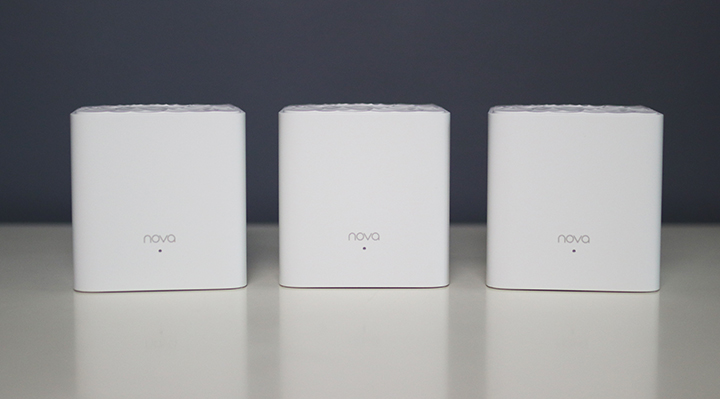Do you find yourself not getting enough WiFi coverage in your house? Tenda, a popular modem and router, is offering an inexpensive way to boost your WiFi signal and remove dead spots at your home: the Nova MW3. Its an AC 1200 dual-band mesh WiFi system that supports MU-MIMO technology. The box comes with three nodes that could theoretically provide 300 square meters of WiFi coverage. Today, we’ll discuss the Nova MW3, its setup process, and features to help you decide whether it’s the mesh WiFi system for you.
Table of Contents
Out of the box, you get three Nova MW3F nodes, three power adapters, and a LAN cable to connect the primary node to your router.

The body is made of hard, smooth plastic. It appears to be solidly built, with no flex or creaking when squeezed. It does, however, feel hollow. At the front, you can find the Nova branding, as well as the LED indicator. The LED indicator shines a solid green light when it’s getting an excellent connection, yellow for a fair connection, and red when it’s disconnected from the other nodes.

At the back, you can find the reset switch, WAN/LAN port (for the primary node), LAN port, and the power in port.

At the bottom, you can find the product information, QR code for adding additional nodes, as well as two mounting latches to mount them to your wall or ceiling.

Setting up the Tenda Nova MW3 was a breeze. It took me less than 5 minutes to set up the primary node. Then it was off to find the best places to put the other two.

Surprisingly, the Tenda Nova MW3 has a lot of network customization and features. You can make network changes on the Tenda app, which is more convenient than going to your router’s default gateway.
Guest Network
Users may set up another SSID for guests, with a separate connection to help make your home network more secure. Users can set up the duration of the network, as well as take it down with just two taps. Unfortunately, there is no way to allocate a specific amount of bandwidth for the guest network.
Parental Controls
Using the parental controls on the Tenda app, users may create groups, assign devices to each group, and set periods of inaccessibility for devices within the group. Unfortunately, users cannot disable specific sites or services from the router.
Smart QoS
By setting how much bandwidth your ISP can output, the Tenda Nova MW3 can intelligently allocate the bandwidth to the user’s need, ensuring uninterrupted streaming, or low ping when gaming. Unfortunately, users cannot set any prioritization rules.
Add Aditional Novas
If three nodes are not enough for your need, then you could add more novas into the mesh by merely scanning the Qr code on the bottom of each node.
Fast roaming
Enabling fast roaming allows nodes to hand over clients quickly to another node, which makes connecting from one node to the next more seamless.
Smart Assistant
This connects your device to the 2.4GHz band for 30 minutes so you can find and install other smart products that only operate on this wireless frequency.
UPNP, DHCP Server, DNS, and Port Forwarding
Allows users to enable UPnP, set the DHCP server, change primary and secondary DNS, as well as additional rules for port forwarding.

For PHP 4,999USD 85INR 7,222EUR 81CNY 620, you can have an inexpensive solution to your WiFi dead spot problems. I found no loss in speed when plugged directly to our modem via LAN cable and connecting to the WiFi Mesh from 10 meters away, and I was able to stream five 1080p videos simultaneously from the same distance. While playing Mobile Legends, though, I did get around 5 seconds of ping spikes per game. Overall, the Tenda Nova MW3 was enough for my home needs, but for those looking for more customization and richer features, you may want to look elsewhere. If you’re interested in picking up the Tenda Nova MW3 or other Tenda products, you can visit their Lazada official store here.
Tenda Nova MW3 specs:
Dual-Band: 2.4GHz & 5GHz
WiFi 802.11 ac up to 867Mbps (5GHz), 300Mbps (2.4GHz)
WPA2 PSK security protocol
Firewall: Forbid UDP, TCP, and ICMP flood attack
VPN: IPsec, PPTP, and L2TP pass-through
System requirement: Android 4.0+, iOS 8+
2 * 3dbi internal antennas
1 x ethernet output
1 x hybrid ethernet port (input+output)
90mm x 90mm x 90mm
What we liked:
What we didn’t:

YugaTech.com is the largest and longest-running technology site in the Philippines. Originally established in October 2002, the site was transformed into a full-fledged technology platform in 2005.
How to transfer, withdraw money from PayPal to GCash
Prices of Starlink satellite in the Philippines
Install Google GBox to Huawei smartphones
Pag-IBIG MP2 online application
How to check PhilHealth contributions online
How to find your SIM card serial number
Globe, PLDT, Converge, Sky: Unli fiber internet plans compared
10 biggest games in the Google Play Store
LTO periodic medical exam for 10-year licenses
Netflix codes to unlock hidden TV shows, movies
Apple, Asus, Cherry Mobile, Huawei, LG, Nokia, Oppo, Samsung, Sony, Vivo, Xiaomi, Lenovo, Infinix Mobile, Pocophone, Honor, iPhone, OnePlus, Tecno, Realme, HTC, Gionee, Kata, IQ00, Redmi, Razer, CloudFone, Motorola, Panasonic, TCL, Wiko
Best Android smartphones between PHP 20,000 - 25,000
Smartphones under PHP 10,000 in the Philippines
Smartphones under PHP 12K Philippines
Best smartphones for kids under PHP 7,000
Smartphones under PHP 15,000 in the Philippines
Best Android smartphones between PHP 15,000 - 20,000
Smartphones under PHP 20,000 in the Philippines
Most affordable 5G phones in the Philippines under PHP 20K
5G smartphones in the Philippines under PHP 16K
Smartphone pricelist Philippines 2024
Smartphone pricelist Philippines 2023
Smartphone pricelist Philippines 2022
Smartphone pricelist Philippines 2021
Smartphone pricelist Philippines 2020